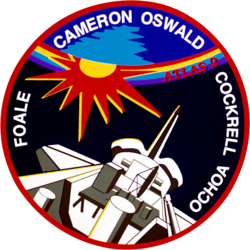Kenneth D. Cameron
| Kenneth Donald Cameron | |
 | |
| NASA-Astronaut | |
|---|---|
| Född | 29 november 1949 Cleveland, Ohio |
| Tid i rymden | 23 dagar, 10 timmar, 11 minuter |
| Urvalsgrupp | Astronautgrupp 11 |
| Uppdrag | STS‑37, STS‑56, STS‑59 |
| Uppdragsemblem | |
Kenneth Donald Cameron, född 1949, är en NASA-astronaut som gjort tre rymdresor.
Biografi
Cameron föddes i Cleveland, Ohio. Efter examen från högskola värvades han till marinkåren och utbildades på Quantico, VA. Efter att han slutfört officerskurs och en kurs i vietnamesiska, blev han förflyttad till Vietnam i ett år som befälhavare. Han blev dekorerad efter 40 strider. Efter att han befordrats, flyttade han till MIT där han tog examen i aeronautik och astronautik. Cameron har loggat över 4 000 timmar tid i 48 olika typer av flygplan.
1984 började Cameron astronautprogrammet vid Nasa. Under hans 12-åriga karriär med Nasa, blev han Nasas första operative chef i Moskva där han arbetade som kosmonaut-utbildare. Han har gjort tre rymdresor, och har loggat över 561 timmar i rymden. Han tjänstgjorde som pilot på STS-37 och befälhavare på STS-56 och STS-74. Hans senaste rymdresa var STS-74, Nasas andra rymdskyttel med uppdrag att möta och docka med Mir.
1996 avgick Cameron från Nasa och marinsoldaterna och arbetar 2009 i Yorktown, Virginia, där han lever med fru och familj.
Rymdfärder
Källor
”Biographical Data” (på engelska) (PDF). NASA. juni 2010. https://www.nasa.gov/wp-content/uploads/2016/01/cameron_kenneth_0.pdf?emrc=9f22cb. Läst 22 juni 2024.
Media som används på denna webbplats
STS-56 Mission Insignia
STS-74 Mission Insignia
- The STS-74 crew patch depicts the orbiter Atlantis docked to the Russian Space Station Mir. The central focus is on the Russian-built docking module, drawn with shading to accentuate its pivotal importance to both STS-74 and the NASA-Mir Program. The rainbow across the horizon represents the Earth's atmosphere, the thin membrane protecting all nations, while the three flags across the bottom show those nations participating in STS-74: Russia, Canada, and the United States. The sunrise is symbolic of the dawn of a new era in NASA space flight , that of International Space Station construction.
STS-37 Mission Insignia
portrait astronaut Kenneth Cameron




